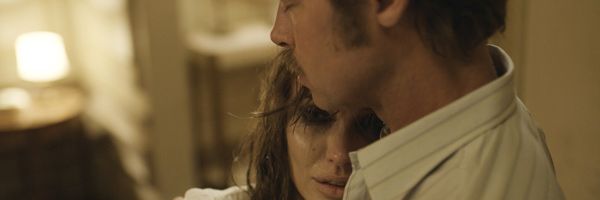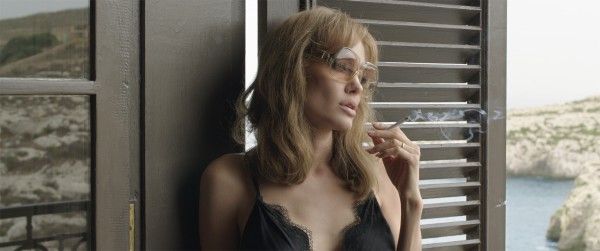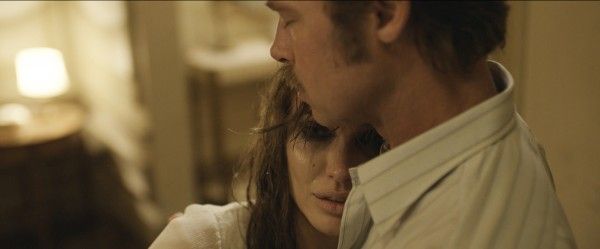Much of the power of Angelina Jolie-Pitt’s By the Sea derives from the casting – namely casting Brad Pitt and herself as a bickering, miserable couple. Here are two of the biggest movie stars on the planet and two of the prettiest people (circa People 2000 & 2006 respectively) arguing and fighting and yelling at one other just like everybody else. The thought crosses that if this “Hollywood Power Couple” can’t make it work (albeit fictionally) what hope do the rest of us mere mortals have. By the Sea, at its best, toys with this line of fiction and reality, using whatever preconceived image you have of ‘Angelina Jolie’ or ‘Brad Pitt’ and upending it, laying it bare, revealing the dark angst within. Which isn’t to say By the Sea is a movie about “Brad and Angie”; but about the perception of who you are versus the reality. And, more often than not, that reality is incredibly depressing.
Brad and Angie are Roland and Vanessa, a chilly American couple, who travel to a hotel in the Mediterranean. Roland, a struggling writer dealing with a bout of writer’s block, hopes the ideal French waterfront will provide him with some semblance of inspiration. Vanessa, the far more enigmatic of the two, immediately retreats to the bed of her hotel room, refusing to leave, only stepping outside to the balcony once or twice. The movie plays coy as to the source behind the couple’s estrangement (although any moderately attentive moviegoer can easily surmise what’s up). There in the hotel room, Vanessa discovers a small hole in the wall, allowing her to peek into the neighboring room at a recently married French couple (Melanie Laurent & Melvil Poupaud).
There’s not actually much in the way of plot to By the Sea. It’s a movie of lingering images. A five minute-sequence of the couple driving, of walking alongside the beach, of Roland drinking and waxing poetic with a widowed barkeep, of Vanessa staring outside her hotel room at a fisherman rowing into the Ocean alone. At times these images can drift from meaningful to just downright languid, the balance between artsy and pretentious tipping to the latter. The first thirty or so minutes are difficult to get through – but then the film finds a second gear within the sad, aging eyes of its two leads. They hover like ghouls around the nubile young bodies of the beach, watching, inspecting, yearning... It’s not long before the couple is spying through the peephole of their room at the younger couple, ‘their younger selves’. By the Sea contrasts the fading beauty of its two movie stars against the marvelous ocean and bright yellow beach sands. The notion that this place is timeless, unchanging, forever – whereas Roland & Vanessa & Brad & Angie will change and age and fall away into nothing. The sea, though, will remain just as it ever was.
By the Sea doesn’t trust its audience enough. It repeats the same images over and over again. The lone fisherman going out to sea - powerful the first three times, yet tiresome the next three. It’s as if the film expects you to doze off – and so, just in case you missed it, reprises the same images, the same beats, the same arguments – that way you’re all caught up. By the Sea desperately needs to explain itself – scenes toward the end ‘revealing’ the source of the couple’s problems and the significance of the fisherman rowing into the ocean. It’s a film that wants you to understand, to feel what it feels, and for three-fourths it does just that; until it questions if you really get it at all and so it gently sits you down and explains exactly what to feel and what’s been happening the whole time.
It’s a beautiful movie though, elegantly shot and composed, using jump cuts ruthlessly to suggest the passage of time and how quickly happiness can fade. Between her first three films, Jolie-Pitt has proven herself to have an excellent eye and the work she does here with cinematographer Christian Berger (Cache) is a marvel, perfectly recapturing the feel of the seventies Euro-art films.
If By the Sea ultimately fails, it at least does so spectacularly. It’s so earnest and heartfelt that it’s impossible to outright dismiss. There’s so much that works here (Pitt and Jolie are both terrific, the earthy cinematography, the pitch-perfect tone) that when it falters in the end, it doesn’t bother as much as it should. By the Sea works in the larger sense – in dissecting the mythos of its leads, in its fascination with our past selves and in our inability to become who we once were.
B




